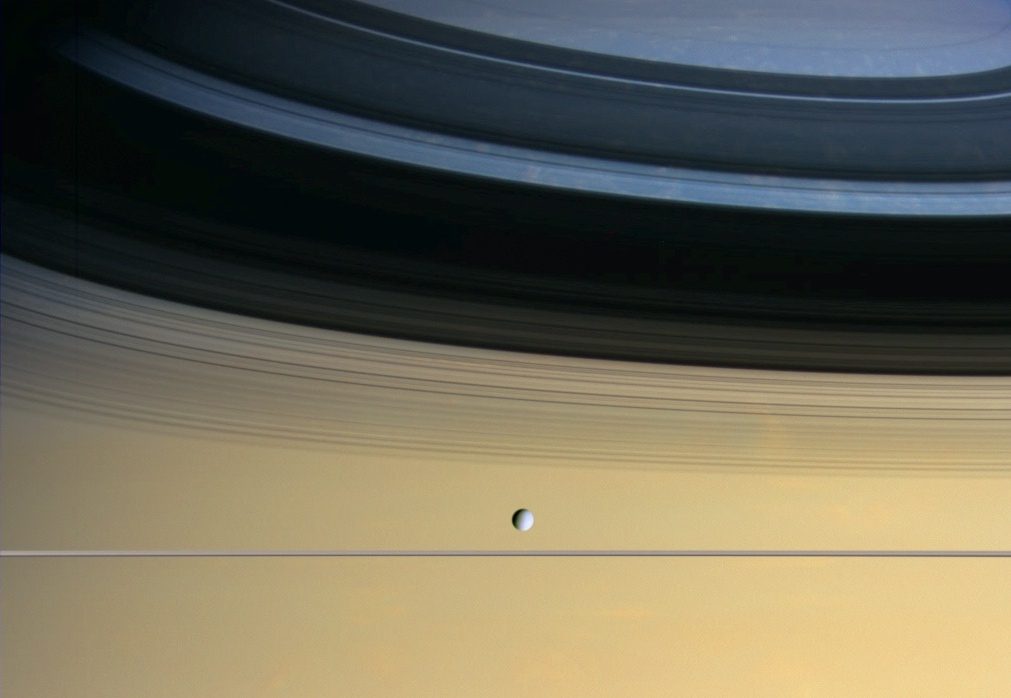This article explores 10 mysteries about Saturn’s moon, Enceladus. Among the mysteries discussed are the geysers found at its south pole, the source and heating of the subsurface oceans, the internal structure of Enceladus, the origin of its water, the age of its geysers, the potential for life on the moon, the composition of its oceans, the gravity field, and future exploration. Despite many years of study, these fascinating topics about the icy moon remain unsolved, and it is hoped that future missions will provide further insights and discoveries.
1. Introduction
Saturn’s moon Enceladus is one of the most fascinating objects in our solar system. It has been the subject of numerous studies and observations, yet there are still many mysteries about this icy moon that remain unsolved. In this article, we will look at 10 unsolved mysteries about Enceladus.
2. Geysers on Enceladus
One of the most remarkable features of Enceladus is the geysers that erupt from its south pole. These geysers shoot plumes of water vapor, ice particles, and other material into space. While scientists have a good understanding of how the geysers work, they are still trying to understand the source of the water and how it is being heated.
3. Tidal Heating
Most of the heat that keeps Enceladus warm comes from tidal heating. This happens when gravitational forces from Saturn tug on the moon’s icy surface, causing it to flex and stretch. This process generates heat that melts the ice, creating subsurface oceans. However, scientists are still trying to determine exactly how much heat is being generated and how it is being distributed throughout the moon.
4. The Internal Structure of Enceladus
To understand how Enceladus works, scientists need to know its internal structure. However, this is difficult to determine from the outside. Some measurements suggest that Enceladus has a rocky core surrounded by a layer of liquid water, but more data is needed to confirm this.
5. The Origin of Enceladus’ Water
Enceladus is covered in a layer of ice, but it also has subsurface oceans of liquid water. Scientists are still trying to determine where all of this water came from. One possibility is that it was delivered by comets or asteroids early in the moon’s history. Another theory is that it was created through chemical processes within the moon itself.
6. The Age of Enceladus’ Geysers
The geysers on Enceladus are relatively young, but exactly how young is still a mystery. Some estimates suggest that the geysers are only a few million years old, while others suggest that they could be as old as 100 million years. This has important implications for the moon’s overall geological history and how it has evolved over time.
7. The Potential for Life on Enceladus
The discovery of subsurface oceans on Enceladus has raised the possibility that the moon could harbor life. While scientists have not yet found any evidence of life on Enceladus, they are actively studying the moon to see if it has the necessary conditions to support life.
8. The Composition of Enceladus’ Oceans
Scientists are also interested in understanding the composition of Enceladus’ subsurface oceans. In particular, they are looking for evidence of organic molecules, which are the building blocks of life. Preliminary analysis of the plumes from the geysers suggests that they contain a rich assortment of organic molecules, but more data is needed to confirm this.
9. The Gravity Field of Enceladus
Mapping the gravity field of a planetary body can provide important clues about its internal structure and composition. However, the gravity field of Enceladus is still poorly understood. Scientists are using data from the Cassini spacecraft to create detailed maps of the moon’s gravity field, which will help them better understand its internal structure.
10. The Future Exploration of Enceladus
Despite decades of study, there is still much we don’t know about Enceladus. Future missions to the moon will likely focus on exploring its subsurface oceans and searching for evidence of life. NASA and other space agencies are already planning new missions to Enceladus, and it is likely that we will continue to learn more about this fascinating moon in the years to come.
